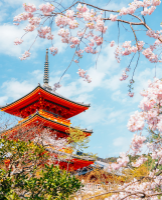I long for Kyoto –
cuckoo!
— Basho, 1690
I made my first trip to Kyoto this past March, and still have yet to come fully back down to earth. Wow!
It’s always a joy to visit a new place, but I did not expect to fall so in love with Japan. My husband Ben went there to visit my sister, who was living in Okinawa. The three of us then took a trip to Kyoto to visit temples and enjoy its famous architecture, gardens, and markets.
This visit got me even more excited for our March 2024 tour. I loved so many things about Kyoto that it was hard to pick five, but here they are.
Tofukuji
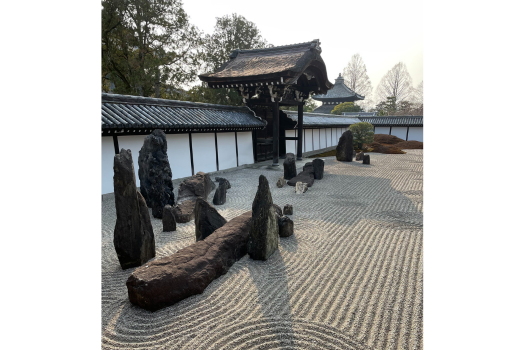
Tofukuji South Garden (Photo by Melanie Blake)
After full day of exploring Kyoto, we were content to sit in the interior courtyard and admire the southern garden and the effects of wind and light. This quiet, peaceful experience was one of the best parts of the trip for me. Time, outside worries, thoughts about what’s coming next—all of those had no meaning inside Tofukuji, which for me is a rare and beautiful thing.
This garden is a traditional Zen dry garden, with real and mythical landscapes re-created in miniature. For example, Horai, the immortal islands of Chinese mythology, are represented by stones set among seas of raked sand. With our local guides, we will explore the symbolism used in Zen gardens and learn about Shigemori’s sometimes controversial innovations.
I also loved the checkered pattern of the Abbott's Garden on the north side, and I am not alone. This unconventional design helped establish Shigemori’s reputation. Shigemori said he was inspired by the checked patterns of the walls of a teahouse in a 17th-century villa. Others saw the influence of painters like Piet Mondrian. Which garden will be your favourite?
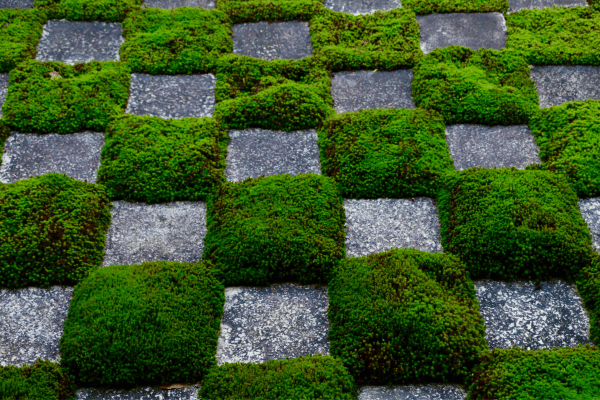
Abott Garden at Tofukuji
The gardens were lovely in early March as signs of spring started to appear. I'll let the pictures speak for themselves.
Ramen + street food
OK, this is technically two things, but it was just too hard to choose.
Ramen was our go-to meal in Japan, and it never disappointed. It was quick, affordable and invariably delicious. My longtime favourite is tonkatsu broth, made by cooking down pork bones and often other parts like trotters until you get a rich, creamy silky base for the soup.
But in Kyoto I branched out and tried the many styles that were available; one of the best bowls was a beef-based ramen from a no-nonsense place on Ramen koji (Ramen Street), a collection of restaurants at the top of Isetan department store in Kyoto Station. I loved its simple but deep, savoury flavour. Vegetarian and vegan ramen is also easy to find.
With each bowl, we experimented with different levels of spice and noodle firmness. Firm noodles are the way to go, and I always add a poached or soft-boiled egg. I like a lot of spice, but I definitely overdid it with this bowl of ramen.
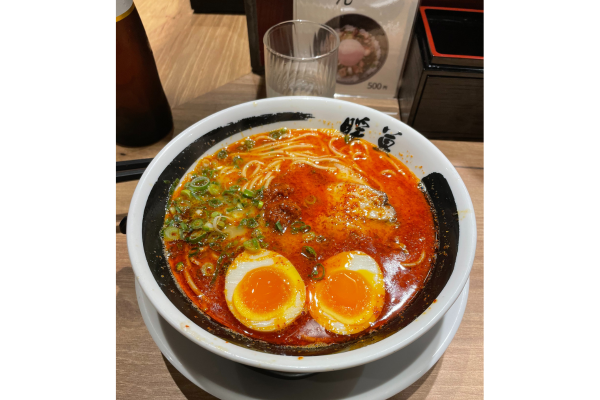
Spicy Ramen (Photo by Melanie Blake)
Other food favourites: Refreshing vegetarian soba with mushroom and burdock root at a tiny restaurant with traditional low tables in the Gion neighbourhood; roasted chestnut soft-serve ice cream; fatty toro (tuna belly) sashimi at Nishiki market; and takoyaki (balls of minced or diced octopus fried in batter) at the stalls outside Inari temple.
Ben loved the roasted mochi on skewers. I did not like that as much, but maybe you will!
Plum blossoms
One of Kyoto’s most famous traditional epithets is “the flowering capital,” an image evoked by this 9th-century poem:
Wherever I look
willow is mixed with cherry blossom —
the capital, indeed,
has turned into a spring brocade
When we visited Kyoto in early March, we were too early for sakura. It was hard to be disappointed, though, when took our first stroll along the Kamo River and were drawn to the delicate, delicious fragrance of plum blossoms.
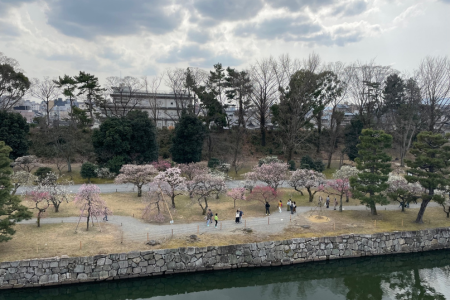
Plum blossoms on the river (Image by Melanie Blake)
Being among other people who were delighting in these flowers was as fun as admiring them ourselves. Throughout Kyoto, there were opportunities to wander among the early “spring brocade” and share in the experience with people who were doing the same. One of my favourite spots was the plum and peach groves in the Gyoen National Garden—just across the street from our hotel for the tour. Along with white, pink and red plum blossoms, these groves contain the remains of an imperial residence where Murasaki Shikibu, author of The Tale of Genji, lived at one point.
A bonus was that the various Japanese prefectures don't wait for blooms to appear to celebrate the sakura. Once the sakura season starts down south in Okinawa and the other Ryukyu islands around mid-January , across Japan you can get everything from sakura lattes, cream puffs and Kit Kats to sakura onigiri (rice balls stuffed with pickled sakura), sakura beer and sakura potato chips. The chips are surprisingly good!
At some of the onsen (public hot springs baths) we visited, one of the women's pools had been tinted pink, with a cherry-blossom fragrance. Full-body sakura.
If spring arrives on schedule, on our tour you’ll have the best of both worlds—the sakura festivities, but without the crowds or elevated prices, and the lovely plum blossoms.
Nijo Castle
I’ve been to a lot of castles. And although I love history and architecture, I also have little patience for an ABC (another bloody castle/church/cathedral) tour, where the day is spent passing from monument to monument trying to keep track of who killed who and what burned down when.
Nijo Castle was a surprise hit for me. That was partly because I was not as familiar with Japanese castle architecture and design as with European design. The excellent audio guide opened up a whole new realm of knowledge about politics and culture in the Edo period (1600–1868).
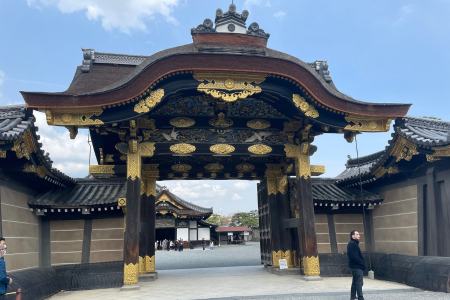
Nijo Castle entrance (Image by Melanie Blake)
Nijo was the base of power of the Tokugawa shogunate, and it was fascinating to follow the thread of form following function, shogun-style: We gleefully tiptoed along the “nightingale” floors that were meant to squeak and thus give away intruders.
The golden painted sliding screens were a visual feast. We moved slowly through the castle, pointing out to each other details in the murals of changing seasons and fierce animals like tigers and hawks. The massive painted pine trees seemed almost three dimensional. Many of the colours and motifs used were also markers of status and rank in the strictly hierarchical shogunate.
To protect these delicate paintings, pictures are not allowed. You have to see them for yourself! Even in their more sober early spring mode, the gardens also drew us in. They echoed the design and symbolism of the Zen temple gardens, but on a much larger scale. Toward the end of our visit, we wandered up on the ramparts and enjoyed the fragrance of a grove of plum trees wafting toward us.
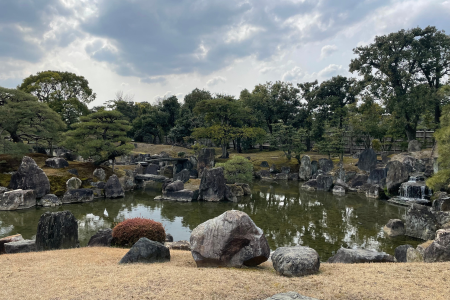
Nijo Castle Gardens (Photo by Melanie Blake)
Tanka
Tanka are short poems of 35 on, which are similar to syllables. This form has flourished for centuries in Kyoto and throughout Japan. In earlier times, imperial and noblemen, noblewomen, and monks wrote tanka for all kinds of public and private occasions.
Tanka generally don’t rhyme. Instead, they rely on double or triple meanings, repeated sounds, and allusions, especially to classical Chinese poetry. Lady Murasaki Shikibu, author of our tour reading The Tale of Genji, wrote hundreds of tanka as part of her epic work. Their layers of meaning reveal the ambiguities and social complexity of life in imperial Kyoto.
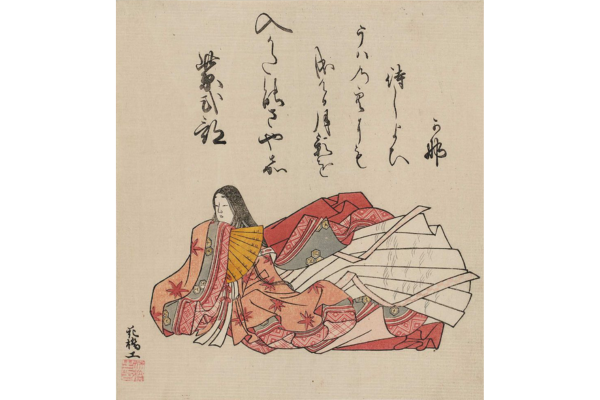
Illustration of Murasaki Shikibu by Komatsuken
Tanka also were and are a form used to capture moments of intense feeling or observation. Since we will be reading Murasaki’s tanka on tour, I’d like to end by sharing two tanka by other poets here.
the fireflies above the stream
seem to be my yearning soul
wandering free of my body
— Izumi Shikibu, 10th century
Even in my dreams
the path I travel disappears —
bamboo at Fushimi village
snaps beneath the weight of snow
— Fujiwara No Ariie, 12th century
I am counting the days until my return to Kyoto, and invite you to join me for Everyday Beauty: Art and Literature of Japan from March 3 - 13, 2024. Learn more about the tour here.
All poem translations from Kyoto: A Literary Guide, edited Dougill et al. Manchester: Camphor, 2020.


